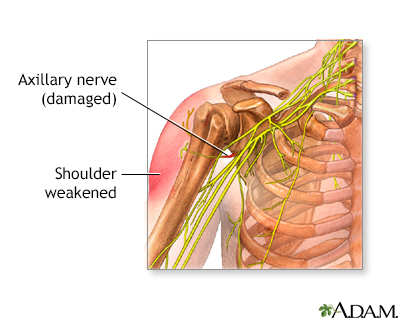Axillary nerve dysfunction
Neuropathy - axillary nerve
Axillary nerve dysfunction is nerve damage that can lead to a loss of movement or sensation in the shoulder.
Images

Causes
Axillary nerve dysfunction is a form of peripheral neuropathy. It occurs when there is damage to the axillary nerve. This is the nerve that helps control the deltoid muscles of the shoulder and the skin around it. A problem with just one nerve, such as the axillary nerve, is called mononeuropathy.
The usual causes are:
- Direct injury
- Long-term pressure on the nerve
- Pressure on the nerve from nearby body structures (entrapment)
- Shoulder injury
Entrapment creates pressure on the nerve where it passes through a narrow structure.
The damage can destroy the myelin sheath that covers the nerve or part of the nerve cell (the axon). Damage of either type reduces or prevents the movement of signals through the nerve.
Conditions that can lead to axillary nerve dysfunction include:
- Body-wide (systemic) disorders that cause nerve inflammation
- Deep infection
- Fracture of the upper arm bone (humerus)
- Pressure from casts or splints
- Improper use of crutches
- Shoulder dislocation
In some cases, no cause can be found.
Symptoms
Symptoms may include any of the following:
- Numbness over part of the outer shoulder
- Pain in the shoulder region
- Shoulder weakness, especially when lifting the arm up and away from the body (shoulder abduction)
Exams and Tests
Your health care provider will examine your neck, arm, and shoulder. Weakness of the shoulder can cause difficulty moving your arm.
The deltoid muscle of the shoulder may show signs of muscle atrophy (loss of muscle tissue and thinning).
Tests that may be used to check axillary nerve dysfunction include:
- Electromyography (EMG) and nerve conduction tests will likely be normal right after the injury and should be done several weeks after the injury or symptoms start
- MRI, ultrasound, or x-rays of the shoulder
Treatment
Depending on the cause of the nerve disorder, some people do not need treatment. The problem may get better on its own. The rate of recovery is different for everyone. It can take many months to recover.
Anti-inflammatory medicines may be given if you have any of the following:
- Sudden symptoms
- Small changes in sensation or movement
- No history of injury to the area
- No signs of nerve damage
These medicines reduce swelling and pressure on the nerve. They may be injected directly into the area or taken by mouth.
Other medicines include:
- Over-the-counter pain medicines may be helpful for mild pain.
- Medicines to help reduce stabbing pain (neuralgia).
- Opioid pain relievers are rarely helpful for neuropathic pain.
If your symptoms continue or get worse, you may need surgery. If a trapped nerve is causing your symptoms, surgery to release the nerve may help you feel better.
Physical therapy can help maintain muscle strength. Job changes, muscle retraining, or other forms of therapy may be recommended.
Outlook (Prognosis)
It may be possible to make a full recovery if the cause of the axillary nerve dysfunction can be identified and successfully treated.
Possible Complications
Complications may include:
- Deformity of the arm, shoulder contracture, or frozen shoulder
- Partial loss of sensation in the arm (uncommon)
- Partial shoulder paralysis
- Repeated injury to the arm
When to Contact a Medical Professional
Contact your provider for an appointment if you have symptoms of axillary nerve dysfunction. Early diagnosis and treatment increase the chance of controlling symptoms.
Prevention
Preventive measures vary, depending on the cause. Avoid putting pressure on the underarm area for long periods. Make sure casts, splints, and other appliances fit properly. When you use crutches, learn how to avoid putting pressure on the underarm.
Related Information
Peripheral neuropathyMononeuropathy
Systemic
Multiple mononeuropathy
Broken bone
How to make a splint
Muscle function loss
Numbness and tingling
Contracture deformity
References
Chad DA, Bowley MP. Disorders of nerve roots and plexuses. In: Jankovic J, Mazziotta JC, Pomeroy SL, Newman NJ, eds. Bradley and Daroff's Neurology in Clinical Practice. 8th ed. Philadelphia, PA: Elsevier; 2022:chap:105.
Hess DE, Taylor KF, Chhabra AB. Nerve entrapment. In: Miller MD, Thompson SR, eds. DeLee, Drez, & Miller's Orthopaedic Sports Medicine. 5th ed. Philadelphia, PA: Elsevier; 2020:chap 54.
Pierrie SN, Loeffler BJ. Common nerve injuries about the shoulder. In: Skirven TM, Osterman AL, Fedroczyk JM, Amadio PC, Feldscher SB, Shin EK, eds. Rehabilitation of the Hand and Upper Extremity. 7th ed. Philadelphia, PA: Elsevier; 2021:chap 47.
BACK TO TOPReview Date: 2/11/2025
Reviewed By: Joseph V. Campellone, MD, Department of Neurology, Cooper Medical School at Rowan University, Camden, NJ. Review provided by VeriMed Healthcare Network. Also reviewed by David C. Dugdale, MD, Medical Director, Brenda Conaway, Editorial Director, and the A.D.A.M. Editorial team.

Health Content Provider
06/01/2025
|
A.D.A.M., Inc. is accredited by URAC, for Health Content Provider (www.urac.org). URAC's accreditation program is an independent audit to verify that A.D.A.M. follows rigorous standards of quality and accountability. A.D.A.M. is among the first to achieve this important distinction for online health information and services. Learn more about A.D.A.M.'s editorial policy, editorial process and privacy policy. A.D.A.M. is also a founding member of Hi-Ethics. This site complied with the HONcode standard for trustworthy health information from 1995 to 2022, after which HON (Health On the Net, a not-for-profit organization that promoted transparent and reliable health information online) was discontinued. |
The information provided herein should not be used during any medical emergency or for the diagnosis or treatment of any medical condition. A licensed medical professional should be consulted for diagnosis and treatment of any and all medical conditions. Links to other sites are provided for information only -- they do not constitute endorsements of those other sites. © 1997- 2025 A.D.A.M., a business unit of Ebix, Inc. Any duplication or distribution of the information contained herein is strictly prohibited.
